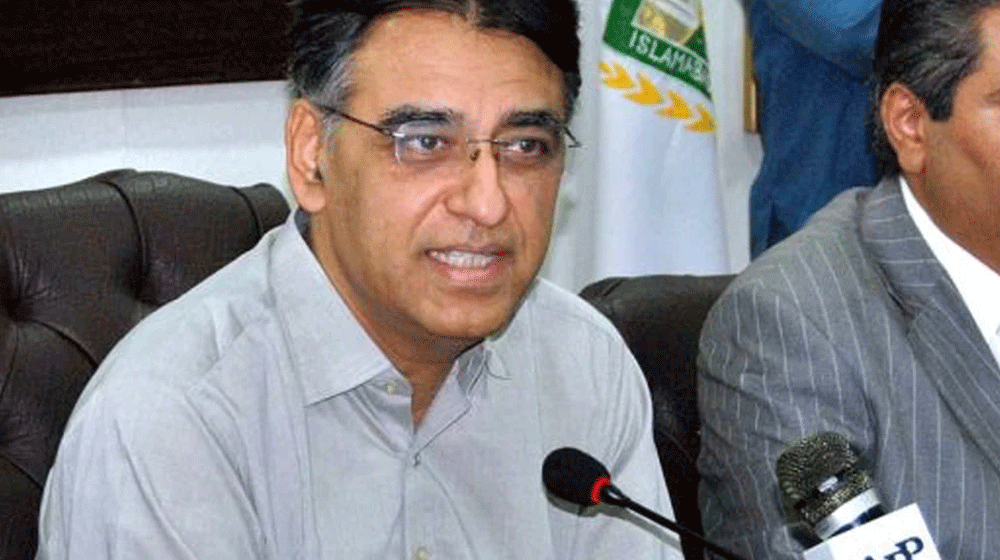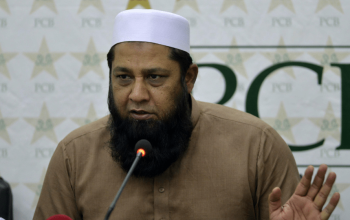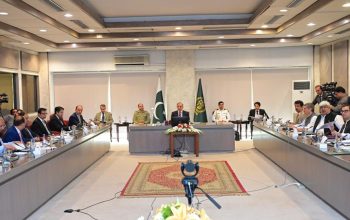The Federal Minister for Planning and Development Asad Umar, announced that the National Economic Council (NEC) has approved the allocation of Rs. 2.10 trillion for the country’s development program.
This included Rs. 87 billion for the China-Pakistan Economic Corridor (CPEC) for 2021-22 against Rs. 1,527 billion for 2020-21, with an increase of 36.4 percent.
ALSO READ
Bank Loans to Private Sector Increased to Rs. 489.5 Billion
Flanked by the Chairman of the CPEC Authority, Asim Saleem Bajwa, during his briefing regarding the allocations for the Public Sector Development Program (PSDP), Minister Umar said that the allocation for the federal development budget is Rs. 900 billion for 2021-22 against Rs. 650 billion for 2020-21, while the provincial development budget is Rs. 1,202 billion for 2021-22 against Rs. 867 billion for 2020-21.
Provincial Development Budgets
The development budget of Punjab is Rs. 500 billion for 2021-22, against Rs. 310 billion for 2020-21; Sindh has Rs. 321 billion against Rs. 194 billion; Balochistan has Rs. 133 billion against Rs. 89 billion; and Khyber-Pakhtunkhwa has Rs. 248 billion against Rs. 274 billion.
He said that one of the reasons for the projected 4.8 percent growth in the next fiscal year which may be more than five percent is that the development budget has been increased significantly.
He said that there had been a huge difference in the allocation and actual expenditure during 2017-18, and did not seem to be normal. Therefore, he had preferred five-year-old data (2016-17). At that time, the total allocation had been Rs. 800 billion but is Rs. 900 billion now.
Energy & Infrastructure
Minister Umar said that 56 percent of the funds of the total estimate had been allocated for the energy and transport projects in 2016-17, and that they have been reduced to 40 percent in 2021-22.
ALSO READ
SBP Plans to Offer New Loan Scheme for Cottage Industry
He said that reducing the PSDP does not mean that the development work in the road transport and communication sector is being reduced, but that it would make more roads and would use alternative sources of funding such as public private partnerships.
He remarked that the allocation of Rs. 244 billion had been for the motorways, highways, interprovincial/districts roads, airport, and railway projects in 2021-22, in which 3,261 km of new roads will be added to the network
The major projects include the Khyber Pass Economic Corridor Project (Rs. 8.5 billion), the Sukkur–Hyderabad Motorway land (Rs. 4.6 billion), the Eastbay Expressway Gwadar (Rs. 2.1 billion), the dualization and improvement of the existing N-50-Yarik-Sagu-Zhob — 210 km (Rs. 1.6 billion), the construction of the M–8 Hoshab–Awaran–Khuzdar (Section-2) 168km (Rs. 1.5 billion), the improvement and widening of the Chitral-Booni-Mastuj-Shandur Road (Rs. 2 billion), the roads linking the motorways in the Punjab, the Main Line I (ML-I) (Rs. 6.2 billion), and the Gwadar Airport (Rs. 1.1 billion).
Public-Private Partnership
Minister Umar said that the major focus is on the PPP projects, including the approval of 14 high-impact PPP transactions over Rs. 978 billion expected in April to October 2021. The major projects include the Sialkot-Kharian Motorway, the Sukkur-Hyderabad Motorway, the Karachi-Quetta-Chaman Road, the Karachi Circular Railway, the Karachi-Pipri Freight, Corridor, and Railway Hospitals.
He said that the PSDP requirements do not equal the resources for infrastructure development.
ALSO READ
SECP Revamps REIT Regulations to Promote Real Estate Activity in Organized Sector
Therefore, in collaboration with the private sector through the Public Private Partnership, megaprojects will be carried out, for which the Viability Gap Fund (VGF) has been created.
No amount had been allocated for it in 2016-17, but now seven percent has been allocated for 2021-22.
The VGF has been allocated in the PSDP for the first time to the tune of Rs. 61 billion. Further, four percent had been allocated to the water sector in 2016-17, which has been increased to 10 percent in 2021-22.
Minister Umar was of the view that the nation could not be united through tanks and guns, and that uniform development in all the areas is needed to unite the nation. He said that the first work on three dams has been started.
Hydropower Projects
The investment in the building of large dams and a water conservation system as per the commitment under the National Water Policy, a new cultivable command area of 100,000 acres developed during 2020-21, and another 200,000 acres is to be added during the next two years, Diamer–Bhasha, Mohmand, and Dasu (Rs. 84.5 billion), K-IV, Nai Gaj Dam, Rainee Canal and Small Storage Dams in Sindh (Rs. 25 billion), Kachhi Canal Balochistan, Awaran, Winder and Panjgur Dams (Rs. 8.2 billion) and small/medium dams in Balochistan, and Ghabbir Dam and Papin Dam in the Punjab (Rs. 3.65 billion).
ALSO READ
Asad Umar Confirms Karachi Green Line Project Launch Date
He further said that for the energy sector investment, including the de-bottlenecking and up-gradation of the transmission system (Rs. 100 billion).
He remarked that earlier, it had been decided to shut down the low-efficiency plant, and that only the high-efficiency line is to remain operational, for which it is important to upgrade the transmission system, and then it would be possible to shut the low efficiency plants.
Further investment is being carried in the loss reduction and rehabilitation projects in high loss DISCOs, the focus on the provision of electricity and gas to the CPEC SEZs, the K2 and K3 coastal power projects Karachi (Rs. 16.5 billion), the Tarbela 5th extension HPP (Rs. 4.6 billion), and the Evacuation of Power from Suki Kanari (Rs. 5.5 billion), and the interconnection of the isolated Makran network at Basima (Rs. 5 billion).
He said that in the social sector, regional equalization had been allocated 23 percent in 2016-17, which has been increased to 31 percent in 2021-22.
Other Development Projects
Minister Umar said that the Higher Education Commission (HEC) had been allocated 2.7 percent of the budget in 2016-17, which has been increased to 4.9 percent.
ALSO READ
NEPRA to Expand Renewable Energy Footprint to 30% by 2031
The minister said the HEC allocation has been increased to Rs. 44 billion, which means that 105 universities will benefit from 120 projects and scholarship schemes of around five billion that will help more than 6,000 scholars and faculty members.
He said that the flagship Billion Tree Tsunami Project is to continue with an allocation of Rs. 14 billion, and that Rs. 51 billion had been spent on the health sector in the outgoing fiscal year.
Minister Umar said that special packages in the PSDP have been added to reduce regional disparities, including an accelerated development plan for Southern Balochistan, the Karachi Transformation Plan, the Socio-Economic Development of Gilgit-Baltistan, the Sindh Development Plan for 14+ Priority Districts, and the allocation for the Newly-Merged Districts of Khyber-Pakhtunkhwa enhanced.
He said that the production sector, like industries and agriculture, needs to be focused on for growth.
ALSO READ
Sindh Proposes 10 New Projects in Karachi in Upcoming Budget
He said that two percent had been allocated for the production/Science and Technology/IT sector in 2016-17, which has been increased to five percent in 2021-22.
CPEC
Minister Umar stated that the PSDP allocation for the CPEC projects is Rs. 87 billion. These include the CPEC Transport and Communication projects (Rs. 78 billion), projects for Western Alignment (Rs. 42 billion), and the CPEC SEZs such as Dhabeji, Rashakai, Faisalabad, and Bostan (Rs. 7 billion).
The Chairman of the CPEC Authority, Asim Saleem Bajwa, said that development projects of the CPEC have been integrated into the national annual plan.
He remarked that one section of eastern alignment (Sukkur-Hyderabad) was missing, for which a different financial model had been introduced and the tendering construction will start soon, after which Karachi to Peshawar would be connected through the motorway. All the peripheral areas will be uplifted.
He added that Hakla-DI Khan of the western route would be commissioned by November, and that DI Khan-Zhob has been included in the JCC with China.
ALSO READ
Gwadar Port and Free Zone Will Generate $10 Billion Every Year: Chairman CPEC
The federal minister said that a five percent budget allocation will be spent on Science and Technology and Information Technology (IT).
Responding to a question, he said that projects are being prioritized as all the projects cannot be run simultaneously. He said that China is still interested in the CPEC projects.
Minister Umar stated that projects of different natures that not been initiated before have been initiated in the CPEC, and that the first phase is of construction, to be followed by agriculture and the industries.
He said that for the first time in the Rashakai industrial zone, a foreign developer (a Chinese company) has brought foreign investment, while more companies are coming.
“You will see a declining trend in the Chinese financing ahead due to different nature of phase,” he remarked.
Furthermore, Chinese companies are working in Pakistan’s agriculture sector in Pakistan, and for the last two years, work on cotton is being carried out and their seed will be available in Pakistan within the next couple of years.
The NEC has decided that no project will be accepted in the PSDP after 31 March so that strategic review may be carried out in April and May.
ALSO READ
Govt Doesn’t Want to Increase Electricity Tariffs for IMF
He said that the financing in the Chinese projects had mainly come in the IPPs. When this financing had been carried in the power sector, the circular debt had also increased.
He said that during the last year of the PML-N government, the circular debt had increased by Rs. 450 billion, and the rate of increase would decrease by Rs. 100-150 billion in the current fiscal year. Due to the delay in the payment, it had been piled up, and the Chinese banks that had given the loans are facing issues in payments.
Now, big decisions have been taken, and payments have been started. With the clearing of the debt, the Chinese financing appetite will increase again. The minister said that the throw forward of the projects is around Rs. 5.5 trillion.
CEO Bajwa said that negotiations on the Industrial Cooperation Framework with the China of Board of Investment and Chinese counterpart are underway. It is a deliverable of the JCC. Nothing has been halted due to it. He further said that the Joint Working Group has already been set on the agriculture sector, and a very intense discussion is being carried out on it.
He further said value chain processing is being discussed with China and in the pre-budget discussions here, and that Chinese private sector participation will be observed in the agriculture sector. Additionally, there is a commitment from the Chinese side to come and participate in the agriculture transformation.
He detailed that the Pakistan People’s Party-led Government of Sindh has not constructed a single inch of motorways in the province, but that the federal government is spending Rs. 200 billion on the Sukkur-Hyderabad Motorway project.
ALSO READ
Pakistan’s Trade Deficit Widens by 30.56%
Besides this, development work on different projects worth Rs. 90 billion in Sindh is in process. Minister Umar said that the federal government is also making efforts to end encroachments and clean the drainage nalaahs in Sindh.
He also said that Rs. 25 billion worth of funds are being spent on water projects in Sindh. “[The] centre works for the welfare of Sindh’s people and not for its government,” he remarked.
He responding to CM Murad’s objections saying that no province, including Sindh, can dictate the Centre regarding the federal development budget.
“It’s the prerogative of the federal government to spend money on projects of its own choice. However, we do take provinces’ input,” he retorted, and added “but they cannot dictate the federal government”.
Minister Umar said that the utilization of the PSDP is expected to remain at 90 percent as compared to 66 percent. Last year’s low utilization had been due to the pandemic. He further said that 320 projects have been targeted to be completed this year.
ALSO READ
Health Ministry Issues Guidelines for Pfizer’s COVID-19 Vaccine
He said the size of the GDP had been Rs. 34 trillion in 2017-18, is Rs. 47.7 trillion in the current period, and will be Rs. 53.9 trillion in the next fiscal year.
He also stated that the approval of the Economic Coordination Committee (ECC) will be sought for the procurement of the COVID-19 vaccine worth $1 billion on Wednesday, and explained that the full resumption of business activities is linked with mass vaccinations.
The post Govt is Allocating Rs. 2.1 Trillion for Development Programs in Budget 2021-22: Asad Umar appeared first on .



